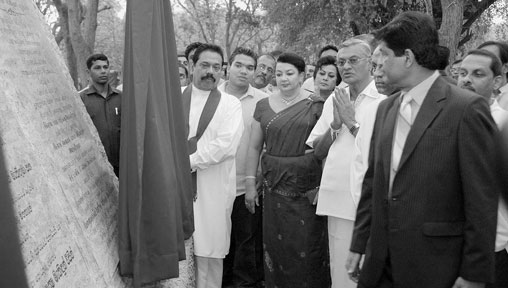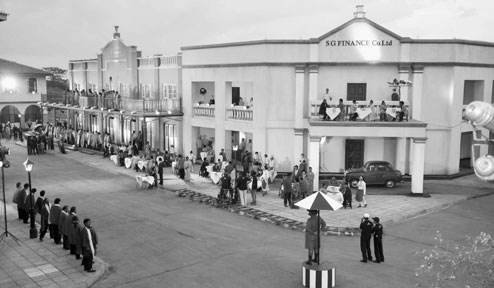Mahinda Rajapaksa Tele-cinema village a boon for film industry
By Ananda KANNANGARA
 |
|
The plaque being
unveiled by President Mahinda Rajapaksa |
Waterfalls, lakes, rivers, mountain ranges and the most important
bio-diversity such as thick jungles with wild animals and birds, tea
estates and unending paddy fields provide natural beauty to a country.
There are only a few rural areas in the country that have these
resources.
The 235-acre picturesque Ranmihitenne tele-cinema village in the
Southern Province has all the attributes of natural beauty.
The Ranmihitenne village, between Kataragama and Tissamaharama in the
Hambantota district was at one time, an unknown area and only a few
villagers engaged in day-to-day agricultural activities.President
Mahinda Rajapaksa having realised the importance of this village, took
prompt action to convert it into a tele-cinema village which was a
long-felt need.
The President opened the tele-cinema village on March 30 with the
participation of over 500 cinema and tele artistes. Subsequently it was
named 'Mahinda Rajapaksa Tele-Cinema Village.'
Mass Media and Information, Secretary, W.B. Ganegala, who extended
his fullest co-operation to the President to complete the project said
that the park has facilities, such as a studio with a giant screen to
view films and teledramas, a stage to shoot films old buildings for film
locations and a high-tech studio to edit films.
 |
|
Mass Media and Information Secretary
W.B. Ganegala |
Most of the buildings have been constructed with wooden planks which
are similar to the original buildings, in Colombo, Galle or Kandy.
He said wooden planks could be removed and replaced with any other
items to suit the needs of film producers. Natural ponds, lakes, jungles
and wild animals, creations similar to paddy fields are other attractive
features for film locations.
There would be more locations when necessary, the secretary said.
"We have also allocated 50 acres for internal landscaping and invited
the Agricultural Department to launch the project. The management of the
Tele-Cinema Village will reserve nearly 100 acres within the park as an
uncleared area to let wild animals and birds roam in their original
habitats.
Asked whether structures similar to bunkers in the North used by Sri
Lanka's Armed Forces would be constructed to be used as film locations,
Ganegala said that such needs will be fulfilled depending on the request
of film directors in future.
Project Manager, Neil Weeratunga said after the Tele-Cinema village
was launched on March 30 over 100,000 persons visited the park and Rs.
2.1 million had been raised.
"During August school vacation and the water-filling ceremony of the
new Hambantota Port over 20,000 people visited and Rs. 1.2 million was
earned as gate collections."
 |
|
The President and First
Lady touring the tele village |
He said the first phase of the Park was constructed at a cost of Rs.
700 million and all expenses were borne by tax collected from screening
foreign films and advertisements on Sri Lanka's television channels.
"The second and third stages of the project will be completed before
the end of next year. New film locations and additional room facilities
would be added," he said.
"The present Tele-Cinema park has about 100 film crew and 10 twin
houses `Villa type' to accommodate 20 persons,".
Weeratunga said a new tele drama 'SLS-', directed by Mahendra Perera
is being shot in the tele-village and moreover a number of inquiries has
been received from film and teledrama directors as well as from
advertising agencies for commercial advertisements.
The final episodes of the Sinhala tele-drama 'Swayan Jathaka',
directed by Sudath Rohana and filmed in the tele- village last month are
telecast over ITN on Sundays," he said. He said a few commercial
advertisements which were shot in the tele-village have been completed.
A German film maker who visited the tele-village recently commended
the film locations and was keen to shoot a war film in the village
shortly.
 |
|
A film location |
Meanwhile, a member of the Worldwide Film Production (WFP) in USA,
William Bowling, on a brief visit to the country last week told the
Sunday Observer that he visited the Ranmihitenna Tele- Cinema Village
and was amazed at the advanced facilities available to films-making.
Bowling said he would explore the possibility of shooting his films in
Sri Lanka in the near future.
Weeratunga said tele-cinema parks are not a new concept and they are
also available in other countries such as India, Pakistan, Uk, USA,
Japan, Malaysia and several other countries in Europe.
The tele-cinema park will also provide skills practices in
cinematography.
"While providing an ultra-modern hall, lecture hall, library, and
practical training facilities, the park will also organise lectures and
workshops, to be conducted by veterans in the trade," he said.
Film producers Directors could use the Yala and the Kumana Bird
sanctuary, salterns, the new airport Hambantota harbour, jungles and
lakes which are in close proximity to the Tele-Cinema park for their
films and teledramas.
|

